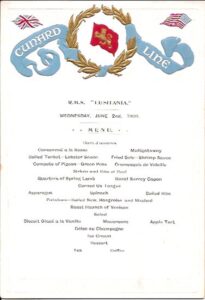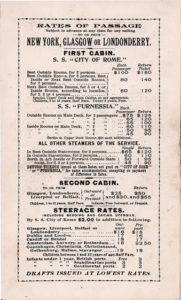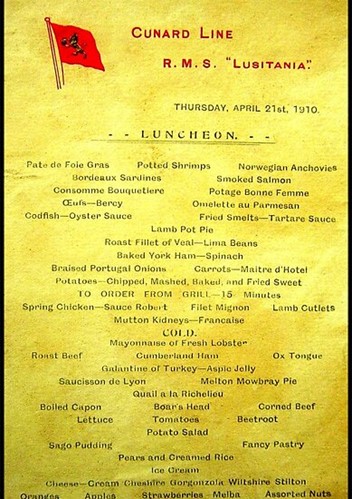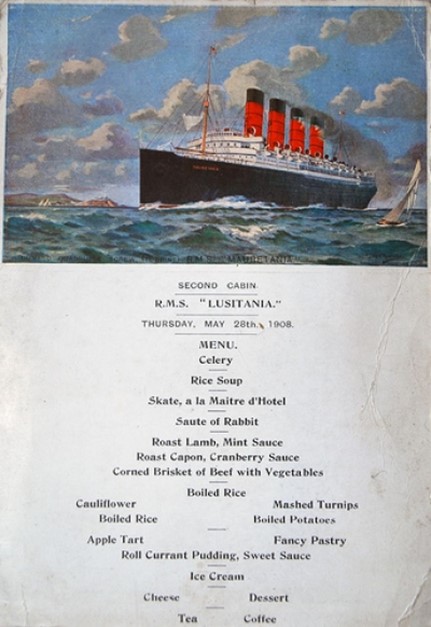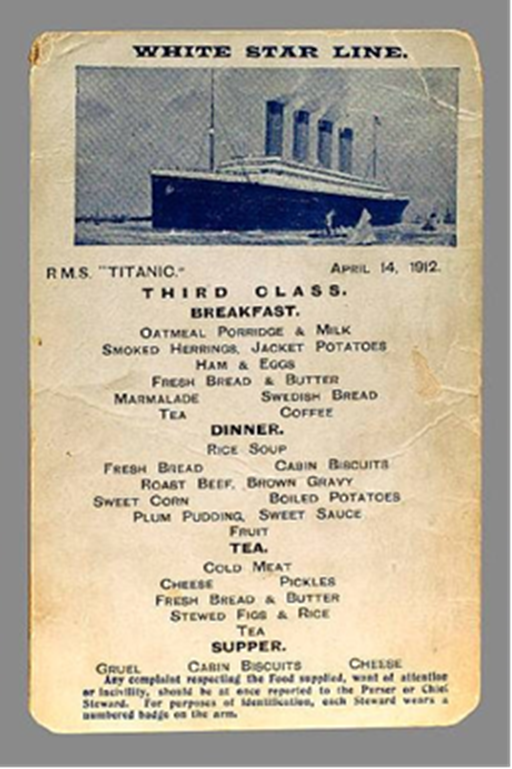When researching an ancestor who immigrated aboard an ocean liner, you may have asked questions about their life and experience—but did you ever wonder what they ate?
During the massive influx of immigrants to the United States in the 19th and early 20th centuries, the food offered onboard liners was much higher quality than what you may be imagining. A large number of ocean liner companies competed for passengers at the time, boasting speed and luxurious accommodations in order to lure passengers. This competition consistently raised the standards of ocean travel for all classes of passengers, even those in third class, who comprised the majority of transatlantic travelers at the time.
I became interested in this subject because of a trip to an antique store. I spotted an ocean liner menu card that seemed original—not a very common find! The proprietor of the store told me that this menu card came from a collection of antiques saved by her father. As it turns out, it was an authentic menu card from the Lusitania, dated June 2nd, 1909, just six years before she was torpedoed by a German U-boat. This was during her 26th voyage and 51st crossing of the Atlantic, from Liverpool to New York.1 However, this card did not specify the class from which it came, which sent me down a rabbit hole of research into the gastronomy of ocean liners as I tried to figure it out. I was able to determine that this menu card came from second class by comparing it to known first and third class menus from the Lusitania and other luxury liners of the time period.
But before we look at that, let’s take a quick step back in time and try to think about these ocean liners in terms of the classes that they carried. Just like with today’s air travel, passengers were able to purchase a first class ticket at a higher price, which meant more space, better food, and better accommodations then the class below them. These classes were set apart from each other by their respective income levels and the occupations they held. First class passengers were people of wealth with disposable income, including the elite, successful entrepreneurs, or even royalty. Second class passengers were generally salaried employees, and the third class consisted mostly of laborers. According to historical gastronomist Andrea Broomfield, the food that was served onboard ocean liners to the different classes offers a glimpse into how the competing lines wanted their passengers to feel. She notes that ships were a “social microcosm in all aspects of the ship outwardly, but the competitive steamship industry forced these barriers to loosen to meet passenger needs.”2 Second and third class passengers were in fact treated a step above how they would be treated on dry land, as the steamship companies competed for ticket sales. Broomfield says that every detail, from “…the setting to the number of courses to the food, was [designed] to celebrate the passengers’ social values while nonetheless exceeding their expectations.”3
This type of treatment can certainly be seen on my menu card from the Lusitania. Second-class passengers receiving this type of gastronomical care would surely have been impressed with the line, and with the ship. Someone was certainly impressed enough to save this card! For example, on my menu card, the first course says “Consommé a la Russe,” which refers to the way in which food is served, with each course presented separately and in sequence. This kind of service would have been taken for granted in first class, but seen as a welcome luxury for second class passengers.
Comparing the Lusitania’s second class menu with other known first class menus, the number of courses and the exquisite fare of the first class becomes clear. Although the type of food is comparable, the increased number of courses sets the classes apart. For example, my menu has desserts of “Biscuit Glace a la Vanille, Macaroons, Apple Tart, Gelee au Champagne and Ice Cream.” The Titanic’s first-class menu from 1912 has “Waldorf Pudding, Peaches in Chartreuse Jelly, Chocolate and Vanilla Éclairs, and French Ice Cream.”4 Although the differences in the menu choices are subtle, the higher quality of the first-class menu items on the Titanic menu is apparent.
The Third class menus, however, are further set apart from the first and second classes. Firstly, the menu choices for the entire day are printed on a single card, while other classes are given separate menu cards for each meal served. Also, the fare is very basic, and the card design is not as elaborate. (This particular card below is an exception—as it was created for the Titanic’s maiden voyage, each card featured an image of the ship).
If you were to think like a third class passenger—for instance, a person coming from Ireland where food availability was scarce—a quick glance at this card could transport the reader to an elite place. These competing ocean liner companies wanted their third classes to feel like royalty, with bountiful food availability a step above what they were most likely used to at home. To be honest, this menu for the day is much better than anything that I typically eat in a day at home!
Notes
1 J. Kent Layton, Lusitania: An Illustrated Biography of the Ship of Splendor (Lulu Press, 2007), 214. “51 West” refers to the Lusitania’s 51st Atlantic crossing. She left Liverpool May 30th and arrived in New York on June 4th, 1909.
2 Andrea Broomfield, “The Night the Good Ship Went Down: Three Fateful Dinners Aboard the Titanic,” Gastronomica: The Journal of Food and Culture 9, No. 4 (2009), 34.
3 Andrea Broomfield, “The Night the Good Ship Went Down: Three Fateful Dinners Aboard the Titanic,” Gastronomica: The Journal of Food and Culture 9, No. 4 (2009), 36.
4 Andrea Broomfield, “The Night the Good Ship Went Down: Three Fateful Dinners Aboard the Titanic,” Gastronomica: The Journal of Food and Culture 9, No. 4 (2009), 38.
Share this:

About Kate Gilbert
Kate is a graduate of Boston University's Genealogical Research Certificate program. She also recently earned a Certificate in American Records from The International Institute of Genealogical Studies. Furthermore, she holds a bachelor’s degree in history from the University of New England, and a Master’s Certificate in Museum Studies from Tufts University. She is excited to share her knowledge and help fellow researchers discover their family roots. Kate is also a Titanic Historian and is fascinated by Maritime History. Areas of expertise: Ireland, French Canada, and New England.View all posts by Kate Gilbert →
